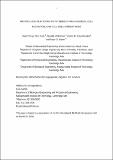Microfluidic Platforms for Studies of Angiogenesis, Cell Migration, and Cell–Cell Interactions
Author(s)
Chung, Seok; Sudo, Ryo; Vickerman, Vernella Velonie V.; Zervantonakis, Ioannis; Kamm, Roger Dale
DownloadKamm-MICROFLUIDIC PLATFORMS FOR STUDIES OF ANGIOGENESIS.pdf (861.1Kb)
OPEN_ACCESS_POLICY
Open Access Policy
Creative Commons Attribution-Noncommercial-Share Alike
Terms of use
Metadata
Show full item recordAbstract
Recent advances in microfluidic technologies have opened the door for creating more realistic in vitro cell culture methods that replicate many aspects of the true in vivo microenvironment. These new designs (i) provide enormous flexibility in controlling the critical biochemical and biomechanical factors that influence cell behavior, (ii) allow for the introduction of multiple cell types in a single system, (iii) provide for the establishment of biochemical gradients in two- or three-dimensional geometries, and (iv) allow for high quality, time-lapse imaging. Here, some of the recent developments are reviewed, with a focus on studies from our own laboratory in three separate areas: angiogenesis, cell migration in the context of tumor cell-endothelial interactions, and liver tissue engineering.
Description
Position paper: Sixth International Bio-Fluid Mechanics Symposium and Workshop March 28–30,
2008 Pasadena, California
Date issued
2010-01Department
Massachusetts Institute of Technology. Department of Biological Engineering; Massachusetts Institute of Technology. Department of Chemical Engineering; Massachusetts Institute of Technology. Department of Mechanical EngineeringJournal
Annals of Biomedical Engineering
Publisher
Springer-Verlag/Biomedical Engineering Society
Citation
Chung, Seok et al. “Microfluidic Platforms for Studies of Angiogenesis, Cell Migration, and Cell–Cell Interactions” Annals of Biomedical Engineering 38.3 (2010): 1164–1177.
Version: Author's final manuscript
ISSN
0090-6964
1573-9686